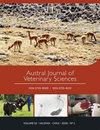In Memory of Dr. med. vet. Gerold Sievers Prekehr (1943–2023)
IF 0.5
4区 农林科学
Q3 VETERINARY SCIENCES
引用次数: 0
Abstract
Gerold Sievers Prekehr was an eminent veterinary parasitologist and former Full Professor at the Faculty of Veterinary Sciences of the Universidad Austral de Chile (UACh) in Valdivia. After obtaining his veterinary degree at the UACh, Prof. Sievers joined the University’s Veterinary Hospital as lecturer. He obtained his doctorate (Dr. med. vet.) in 1973 at the University of Veterinary Medicine Hannover (TiHo), Germany, with a thesis describing a novel method to isolate infective larvae of parasitic nematodes from pasture1. Following a period as scientist in the German pharmaceutical industry, Prof. Sievers returned to Chile in 1975 to take a position as Professor and Director of the Laboratory of Parasitology in the Institute of Animal Pathology at the UACh, roles that he held until his retirement in 2009. During his academic and scientific career of over 40 years, Prof. Sievers studied the biology, epidemiology, diagnosis, prevention and control of several parasites of veterinary and zoonotic importance in Chile. He performed long-term research studies on the seasonal dynamics of parasite egg excretion and development of infective stages of parasitic nematodes of cattle, sheep, horses and cervids in different environments in southern Chile2,3,4. Prof. Sievers also investigated the life cycles and epidemiology of the cattle horn fly Haematobia irritans and the equine bot flies Gasterophilus5, as well as the biology and economic impact of the salmon parasites Ceratothoa gaudichaudii6 and Caligus rogercresseyi. This seminal work provided new understanding on local infection dynamics of several parasite-host systems, allowing the design of prevention and control strategies of endoparasites and ectoparasites based on the principles of “prophylaxis” (management practices of contaminated areas and of animals to avoid clinical parasitoses) and “metaphylaxis” (strategic administration of antiparasitic drugs to reduce the parasite infective stages in the environment). Furthermore, Prof. Sievers performed extensive studies on the field efficacy of anthelmintics in cattle and horses, reporting the first cases of anthelmintic resistance in equine and bovine nematodes in Chile7,8, as well as testing the effects of bioactive forages as complementary parasite control strategy in cattle9. In addition, he conducted investigations on the fertility and viability of hydatid cysts of Echinococcus granulosus in cattle10 and on the environmental contamination with Toxocara canis eggs. For almost 40 years, the didactic and engaging teaching classes of Prof. Sievers captivated the attention of many generations of veterinary students, often combining the纪念兽医博士 Gerold Sievers Prekehr (1943-2023)Gerold Sievers Prekehr (1943-2023)
本文章由计算机程序翻译,如有差异,请以英文原文为准。
求助全文
约1分钟内获得全文
求助全文
来源期刊

Austral Journal of Veterinary Sciences
Veterinary-General Veterinary
CiteScore
1.60
自引率
0.00%
发文量
18
期刊介绍:
Austral Journal of Veterinary Sciences (formerly Archivos de Medicina Veterinaria) publishes original scientific contributions in English, containing the latest developments and discoveries in veterinary sciences. The journal covers topics such as animal health and production, preventive medicine, zoonosis, pharmacology and therapeutics, methods of diagnosis, and other areas related to the veterinary field.
Austral Journal of Veterinary Sciences aims to divulge information about advances in veterinary medicine among universities, research centres, industries, government agencies, biologists, agronomists and veterinarians.
 求助内容:
求助内容: 应助结果提醒方式:
应助结果提醒方式:


